

  |
 Chorionic Villus Sampling - series |
Chorionic villus sampling, or CVS, is a prenatal test that can detect certain genetic abnormalities in the fetus. To perform the test, a physician uses a needle to collect cells from the placenta. These cells are then analyzed for genetic problems.
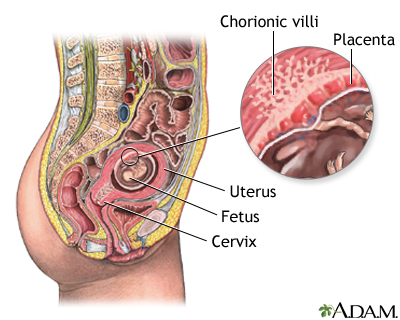
Prenatal testing is often a topic of concern for parents-to-be. It is important to remember that most tests are normal, and abnormal results may open opportunities for successful interventions or informed choices.
CVS is not a routine test. It may be offered to pregnant women who have an increased risk of having a baby with a genetic birth defect that can be detected by CVS. These women include the following:
CVS is usually performed at 10 to 12 weeks of pregnancy. In comparison, amniocentesis is usually performed at 15 to 18 weeks. Although CVS can detect many of the same congenital defects earlier in the pregnancy, it carries about twice as high risk of miscarriage. About 1 in 100 women undergoing CVS will miscarry, as compared with 1 in 200 to 1 in 400 for amniocentesis. Doctors who perform many CVS procedures have the lowest risk of miscarriage, so make sure your health care provider is someone with lots of experience doing CVS.
Early CVS, prior to 9 weeks, sometimes causes birth defects in the limbs, for example, missing fingers and toes, and sometimes malformations in the tongue and jaw. Most physicians agree that CVS should not be done before 10 weeks.
CVS may be chosen as the method of prenatal testing for those unable to have an amniocentesis, and those who may consider a therapeutic abortion in the case of birth defects. If the fetus has serious complications, an earlier abortion is often easier and safer than a second trimester abortion or possible second trimester miscarriage.
Deciding to undergo prenatal genetic testing is a complex, personal decision. You may wish to consult with a genetic counselor to discuss the pros and cons of testing and how the test results may affect you and your family.
Ask your health care provider to fully explain the benefits and risks of the procedure. Before having CVS, your health care provider will ask you to sign a consent form.
You may be asked to drink fluids and refrain from urinating for a few hours before the test. A full bladder can help aid in the proper positioning of the uterus.
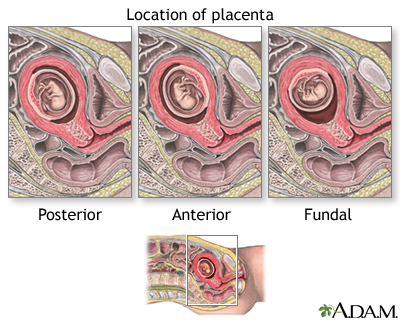
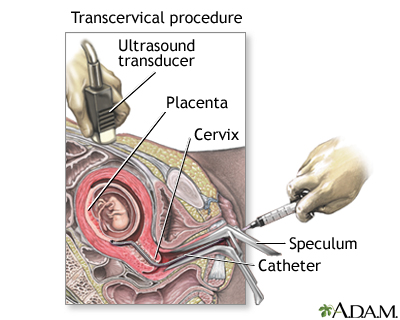
There are two ways to perform CVS: through the cervix (transcervical CVS) and through the abdomen (transabdominal CVS). Transabdominal CVS appears to have a lower risk of miscarriage. If it’s not possible to reach the placenta through the abdomen, the health care provider may go through the cervix.
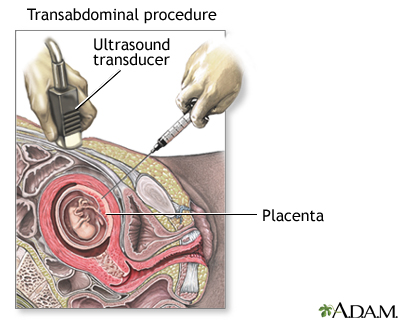
If the test is done through the cervix, the vagina and cervix are cleaned with an antiseptic. Guided by ultrasound, the doctor threads a catheter through the vagina and cervix to the chorionic villus, the threads of tissue (villi) that attach the amniotic sac to the uterine wall.
The doctor then suctions a small amount of the villi with a syringe. The cells of the villi, which usually contain the same genetic information as the fetus, are then analyzed to rule out or detect certain genetic abnormalities.
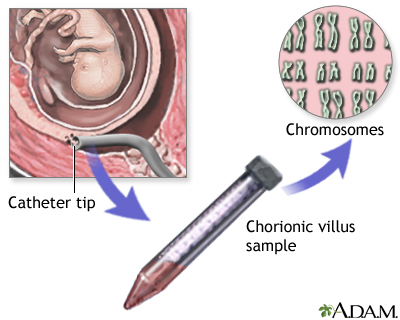
Some women experience no pain with the transcervical CVS; others report feeling a pressure or cramping similar to a pelvic exam.
When CVS is performed through the abdomen, it is much like amniocentesis. An ultrasound is used to guide a thin, hollow needle through the abdomen toward the chorionic villus. Some of the villi are then suctioned through the needle, extracted, and later analyzed.
The transabdominal CVS may feel similar to a blood draw.
Women are often advised to rest for a few hours after CVS. Some women experience cramping or spotting (bleeding) for a day or two after the procedure.
Test results are usually available in a few days to two weeks. More than 95% of women who undergo CVS will find out that their fetus does not have any detectable genetic abnormalities.
CVS can accurately rule out or detect certain genetic abnormalities more than 99% of the time. Sometimes the results of the test are inconclusive. A woman with inconclusive CVS results may choose to have amniocentesis later in her pregnancy.
Your doctor may perform a follow-up ultrasound to make sure the fetus came through the procedure unharmed.
Risks associated with CVS include miscarriage, birth defects, rupture of the amniotic sac, uterine infection, and vaginal bleeding.
Q: Does CVS detect the same abnormalities that amniocentesis does?
A: With the exception of neural tube defects such as spina bifida, CVS can rule out or detect the same genetic disorders as amniocentesis.
Q: In what other ways does CVS differ from amniocentesis?
A: CVS results are generally available from a few days to two weeks after the procedure, whereas amniocentesis results generally take two to four weeks.
Q: If a birth defect is detected in my fetus, can it be treated?
A: There are a few conditions that can be treated prenatally; however, the majority of congenital birth defects detected by CVS cannot be reversed. Future research may lead to additional treatments for specific congenital birth defects. Some couples choose to have an abortion if they learn their fetus has a severe abnormality.